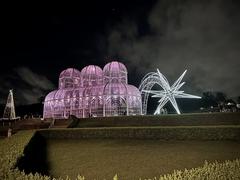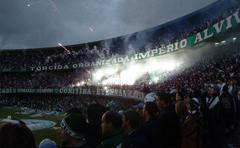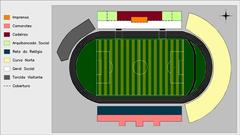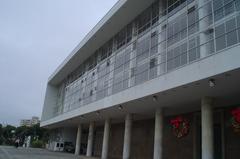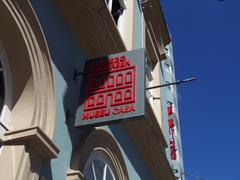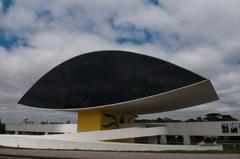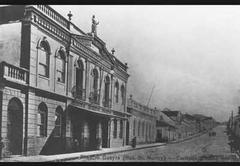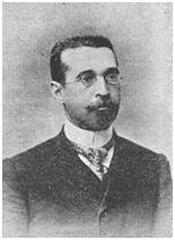Centro Histórico Curitiba: Visiting Hours, Tickets, and Historical Sites Guide
Date: 04/07/2025
Introduction
Curitiba’s Centro Histórico is the living heart of Brazil’s southern capital, offering visitors an immersive journey through centuries of history, architectural diversity, and vibrant cultural life. From its 17th-century origins as a small colonial settlement, the district has evolved into a multicultural urban center—shaped by waves of European immigration, indigenous heritage, and cutting-edge urban planning. This guide provides comprehensive insights into visiting hours, ticketing, accessibility, key historical sites, and practical travel tips to ensure a rewarding and seamless experience for every traveler.
Table of Contents
- Introduction
- Historical Overview
- Cultural Significance
- Key Historical Landmarks
- Visiting Centro Histórico: Hours, Tickets, and Travel Tips
- Events, Guided Tours, and Experiences
- Photography, Shopping, and Dining
- Frequently Asked Questions (FAQ)
- Visuals and Media Guidance
- Conclusion & Call to Action
- References
Historical Overview
Origins and Early Settlement
The roots of Centro Histórico date back to the 17th century with the founding of the Nossa Senhora da Luz dos Pinhais chapel in 1668. This modest wooden structure established the spiritual and civic core of the early settlement, strategically located on the Paraná plateau at the crossroads of cattle and gold routes (e-a-a.com). Gradual expansion throughout the 18th century saw the development of agriculture and cattle ranching, eventually leading to the official recognition of Curitiba as a town (vila) in 1693. Praça Tiradentes, the main square, remains the historic nucleus of the district (e-a-a.com).
Immigration and Urban Growth (19th Century)
The 19th century brought transformative change as European immigrants—Italians, Germans, Poles, Ukrainians, and others—settled in Curitiba, infusing the district with new architectural styles, culinary traditions, and cultural practices (e-a-a.com). Masonry buildings and cobblestone streets began to define the urban landscape. The Santa Felicidade neighborhood, just outside the historic core, remains a testament to this rich immigrant influence.
Modernization and Civic Identity (Early 20th Century)
The early 20th century marked a period of prosperity and modernization, with the construction of grand civic buildings and commercial establishments. The Palácio Avenida, with its classical façade, emerged as a symbol of Curitiba’s sophistication and is now famous for its annual Christmas festivities (e-a-a.com; maxmilhas.com.br). The Catedral Basílica, standing on the original chapel’s site, was rebuilt in a stunning neo-Gothic style and remains a central landmark (e-a-a.com).
Urban Planning and Preservation
Curitiba gained global recognition in the late 20th century for pioneering urban planning strategies, including pedestrianizing key streets and restoring historic buildings. The revitalization of Largo da Ordem as a pedestrian square and the introduction of sustainability-focused initiatives have ensured the district’s preservation while fostering vibrant public life (maxmilhas.com.br; Mobilidade Curitiba).
Cultural Significance
Centro Histórico is celebrated as Curitiba’s cultural and social epicenter. It hosts a range of events—from street fairs and music festivals to religious processions and art exhibitions—reflecting its dynamic, multicultural identity. The district’s gastronomy mirrors its diversity, with Italian, German, Polish, and indigenous influences visible in its restaurants and cafés (maxmilhas.com.br). Institutions like the Museu Paranaense and Centro Cultural Sistema FIEP further enrich the cultural landscape (e-a-a.com).
Key Historical Landmarks
Praça Tiradentes
The symbolic heart of Curitiba, Praça Tiradentes is surrounded by architectural treasures and historical monuments, including glass panels revealing original colonial pavement (e-a-a.com).
Catedral Basílica Menor de Nossa Senhora da Luz
This neo-Gothic cathedral, completed in the early 20th century, features remarkable stained glass and a richly ornamented interior. It stands on the site of the city’s original chapel (e-a-a.com).
Palácio Avenida
A striking early 20th-century building, Palácio Avenida is renowned for its façade and its role in Curitiba’s Christmas celebrations, featuring a beloved holiday light show and choir performances (e-a-a.com; maxmilhas.com.br).
Largo da Ordem
A historic square bustling with activity, recognized for its preserved colonial houses, artisan shops, and the famous Sunday craft fair where local culture comes alive (maxmilhas.com.br).
Museu Paranaense
Located in a historic mansion, this museum houses exhibits on indigenous cultures, immigrant communities, and Paraná state’s history (maxmilhas.com.br).
Other Architectural Highlights
- Casa Romário Martins: The oldest preserved building in Curitiba, now a cultural space (Turistoria).
- Paço da Liberdade: Former city hall, now a vibrant cultural hub (Fui Ser Viajante).
- Palacete Wolf: A 19th-century mansion reflecting immigrant prosperity.
Visiting Centro Histórico: Hours, Tickets, and Travel Tips
Visiting Hours
- Public Squares: Open 24/7 (e.g., Praça Tiradentes, Largo da Ordem).
- Museums (e.g., Museu Paranaense): Tuesday to Sunday, 10:00 AM – 5:00 PM.
- Cathedral: Typically open daily, 7:00 AM – 7:00 PM.
- Casa Romário Martins: Tuesday to Sunday, 10:00 AM – 5:00 PM.
- Paço da Liberdade: Monday to Saturday, 9:00 AM – 7:00 PM.
Always confirm hours with official resources before visiting (Curitiba Turismo).
Tickets and Fees
- Outdoor Sites and Squares: Free entry.
- Museums: Around BRL 10–15, with possible discounts for students/seniors.
- Palácio Avenida: Exterior and Christmas events are free; guided interior tours may require advance booking.
- Special Exhibitions: Some events may require tickets—check online or at visitor centers.
Accessibility
- Pedestrian Areas: Most main streets, including Rua XV de Novembro, are accessible.
- Cobblestones: Some surfaces are uneven; check venue websites for accessibility info.
- Transport: Public buses, taxis, and ride-hailing apps are widely available (Fareja Viagens).
- Restrooms: Available in major attractions and shopping centers, but some older buildings may lack full accessibility features.
Transportation
- On Foot: The district is compact and best explored walking.
- Public Transport: “Linha Turismo” hop-on/hop-off bus covers major sites (tickets ~R$40/day).
- Taxis/Ride-Sharing: Recommended, especially after dark (Fareja Viagens).
- Bicycles: Shared bikes are available via the Tembici app; bike lanes are common.
Safety and Local Etiquette
- Daytime: Generally safe; be alert in crowded areas.
- Nighttime: Use taxis or ride-shares; avoid poorly lit or deserted streets.
- Personal Belongings: Keep valuables secure and be cautious with street vendors (Travel Safe Abroad).
- Dress Code: Casual attire is fine, but dress modestly in churches and museums.
- Tipping: Not mandatory but appreciated (10% in restaurants).
- Photography: Ask permission before photographing people or inside religious spaces.
Events, Guided Tours, and Experiences
- Feira do Largo da Ordem: Sunday street fair with crafts, food, and music (Fui Ser Viajante).
- Christmas at Palácio Avenida: Renowned holiday lights and choir performances (maxmilhas.com.br).
- Guided Walking Tours: Available through local operators or visitor centers; themes include architecture, immigration, and the arts.
- Festivals: Carnival parades, design fairs, and spring/autumn cultural events (Paraná Portal).
Photography, Shopping, and Dining
- Best Photo Spots: Praça Tiradentes, Largo da Ordem, Palácio Avenida, Casa Romário Martins.
- Shopping: Largo da Ordem’s Sunday fair (crafts, antiques), Mercado Municipal (gourmet products), TUTU Sabores Artesanais (STR Specialist).
- Dining: Sample barreado, pão de queijo, and local cuisine at Bar Palácio, traditional cafés, or Mercado Municipal (I Love Curitiba).
Frequently Asked Questions (FAQ)
Q: What are the visiting hours for Centro Histórico Curitiba?
A: Most sites open 9:00 AM–6:00 PM, Tuesday–Sunday. Public spaces are accessible all day.
Q: Do I need tickets for Centro Histórico sites?
A: Outdoor sites are free; museums and exhibitions may charge a nominal fee.
Q: Is the district accessible for visitors with disabilities?
A: Main pedestrian streets are accessible, but some cobblestone areas and historic buildings may present challenges.
Q: Are guided tours recommended?
A: Yes, guided walking tours offer deeper insight into history and culture.
Q: What is the best time to visit?
A: April–May and July–September have pleasant weather. Sundays are lively due to the craft fair.
Visuals and Media Guidance
For your visit or travel planning, refer to official tourism sites and reputable travel blogs for high-quality images and maps.
Image suggestions:
- Panoramic view of Centro Histórico Curitiba
- Casa Romário Martins façade
- Feira do Largo da Ordem market
- Palácio Avenida at Christmas
Use alt tags with keywords such as “Centro Histórico Curitiba visiting hours,” “Curitiba historical sites,” and “Curitiba Centro Histórico tickets.”
Conclusion & Call to Action
Curitiba’s Centro Histórico blends centuries of architectural splendor, multicultural influences, and lively traditions. With its preserved landmarks, accessible design, and calendar of engaging cultural events, the district is a must-visit for travelers seeking history, authenticity, and vibrant urban life.
Plan your visit using official resources, join a guided tour, and immerse yourself in Curitiba’s unique spirit.
Download the Audiala app for personalized travel guides, real-time event updates, and insider tips. Follow us on social media to stay inspired and informed about Curitiba’s Centro Histórico and other cultural destinations.
References
- 10 Best Architectural Buildings in Curitiba, Brazil, 2023, e-a-a.com (e-a-a.com)
- Guide to Curitiba Brazil, 2024, Lonely Planet (Lonely Planet)
- Centro Histórico de Curitiba, 2023, Wikipedia (Wikipedia)
- Melhores Pontos Turísticos de Curitiba, 2024, Fui Ser Viajante (Fui Ser Viajante)
- Centro Histórico de Curitiba, 2024, Curitiba Insider (Curitiba Insider)
- Curitiba Tourism Official Site, 2024, Curitiba Turismo (Curitiba Turismo)
- Curitiba’s Centro Histórico Revitalization Plans, 2024, Mobilidade Curitiba (Mobilidade Curitiba)
- Safety and Travel Tips for Curitiba, 2025, Travel Safe Abroad (Travel Safe Abroad)
- Curitiba Visitor Guide and Tips, 2025, STR Specialist (STR Specialist)
- Curitiba’s Cultural Events and Craft Fairs, 2024, maxmilhas.com.br (maxmilhas.com.br)
- Local News on Centro Histórico Security and Inclusion, 2024, Bem Paraná (Bem Paraná)
- Best Time to Visit Curitiba, 2024, Champion Traveler (Champion Traveler)
- What to Do in Curitiba’s Historic Center, 2025, I Love Curitiba (I Love Curitiba)
- Transportation Options in Curitiba, 2024, Fareja Viagens (Fareja Viagens)
- Turistoria Curitiba Guide (Turistoria)
- Paraná Portal - Centro Revitalization (Paraná Portal)
- Best Time To Visit Curitiba (Best Time To)

